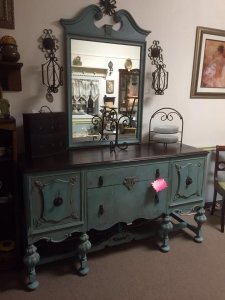What to look for in antique furniture
You’ve seen Antiques Roadshow a few times, but you still don’t know what to look for when you go into an antique store. Are there really hidden treasures that have missed the eye of the resident experts? It’s not likely, but anything is possible. You may come across a great deal or a blatant rip-off, but more often you’re likely to find a piece of interest priced just a little high. So how do you determine if the quality of the item is worth the cost?

When it comes to antiques and even art, much of it is subjective. What something is really worth comes down to what someone is willing to pay for it. You may find an adorable lamp from 1977. It’s someone else’s trash, really. It has a price of $25. Part of the fun of antique shopping is haggling. Almost certainly, you can pay a lower-than-ticket price. You offer $15 and you’ve got yourself a new old lamp. The date is stamped on the thing and you accept it for what it is.
For items presumed to be on the higher end, there won’t always be tell-tale signs to indicate quality or authenticity. There are things to look for, though. If you’re willing to invest a little time, you may increase your chances of making the right antique picks.

Inspect the item thoroughly. If necessary, move it out from the wall or corner. Look at all sides – even the bottom. Most cell phones are equipped with a bright flashlight feature, use it for your examination. If you’re really serious you may want to look at it in the light of day. It is not unreasonable to ask if you may inspect it outside. Prepare to be rejected, people are lazy and don’t want to be responsible for potential damage due to moving something on consignment.

If a piece of furniture is a true antique, quality of construction will be SOLID. If the item creaks as you maneuver it or doesn’t lay flat as it should, it could be damaged or of the modest quality indicative of a later build. Most vintage furniture was made of high quality materials. If an item is heavy, that is a good sign. It indicates solid construction of high end wood. Look for thick veneer, also a common feature of older furniture.
And there are obvious signs of age to seek out, too. Does the finish look like its endured years of wear? Is there dirt firmly engrained into tiny spaces and cracks? Drawers will be worn from use, and the knob or handles should indicate as such.

No wear? No dirt? It may have been refinished. Look on the bottom for signs that a sloppy refinish was applied at some point that could diminish the value. If there simply is no wear it’s probably not old – and that’s not necessarily a bad thing. If the item appeals to you, that’s all the matter. Indicating that it is not truly an antique could add to your bargaining position.
Look closely at the veneer, if the grain is eye-catching and intricate it was likely highly desirable. Such traits are worthy of taking notice and could lead to decent investments. The woods surface should be of even color density save for some imperfections natural to the grain. The impact of scratches and stains will ultimately be at your discretion. Maybe there’s no blemish too distracting, in your opinion. But if you’re spending a few hundred bucks, you’d expect something that was for the most part, flaw-free.
Answers to many questions may be found in the drawers of a bureau. They should be of snug fit, with little to none resistance or wavering. But it’s the joints that may provide the info necessary to accurately date it. Before 1900 most furniture was made with dovetail joints. If they appear sloppy or hand crafted they may date as far back as pre 1830. Look for the dovetails!

Check for missing pieces, patchwork, complete inlays, and unaffected carvings. Give it the twice over – inside, outside, the sides, the bottom… take your time, don’t feel pressured – you aren’t. As a customer you are entitled to do what it takes to be certain of your purchase. And that’s part of the game, if you leave it now, it could be snatched up – you never know.
The furniture’s’ hardware may provide further insight into the piece’s provenance. Can you see the impression of a shape that indicates that an original piece is missing? Look for obvious modifications. Replacement hardware and alterations aren’t necessarily deal-breakers. They may be super-old as well, and if the entire package ‘works’ visually, what difference does it make?
Before agreeing to a final purchase, ask if a guarantee is provided, especially if it is specifically advertised as something special. If you are still unsure, get a second opinion. Again, you risk the item being sold before you return, so be prepared to live with your choice. As stated previously, you are best off buying something because you like it. It is extremely unlikely you are going to unearth a goldmine that will pay your student loans off, but finding something that you personally treasure – that’s a goldmine of the heart.


